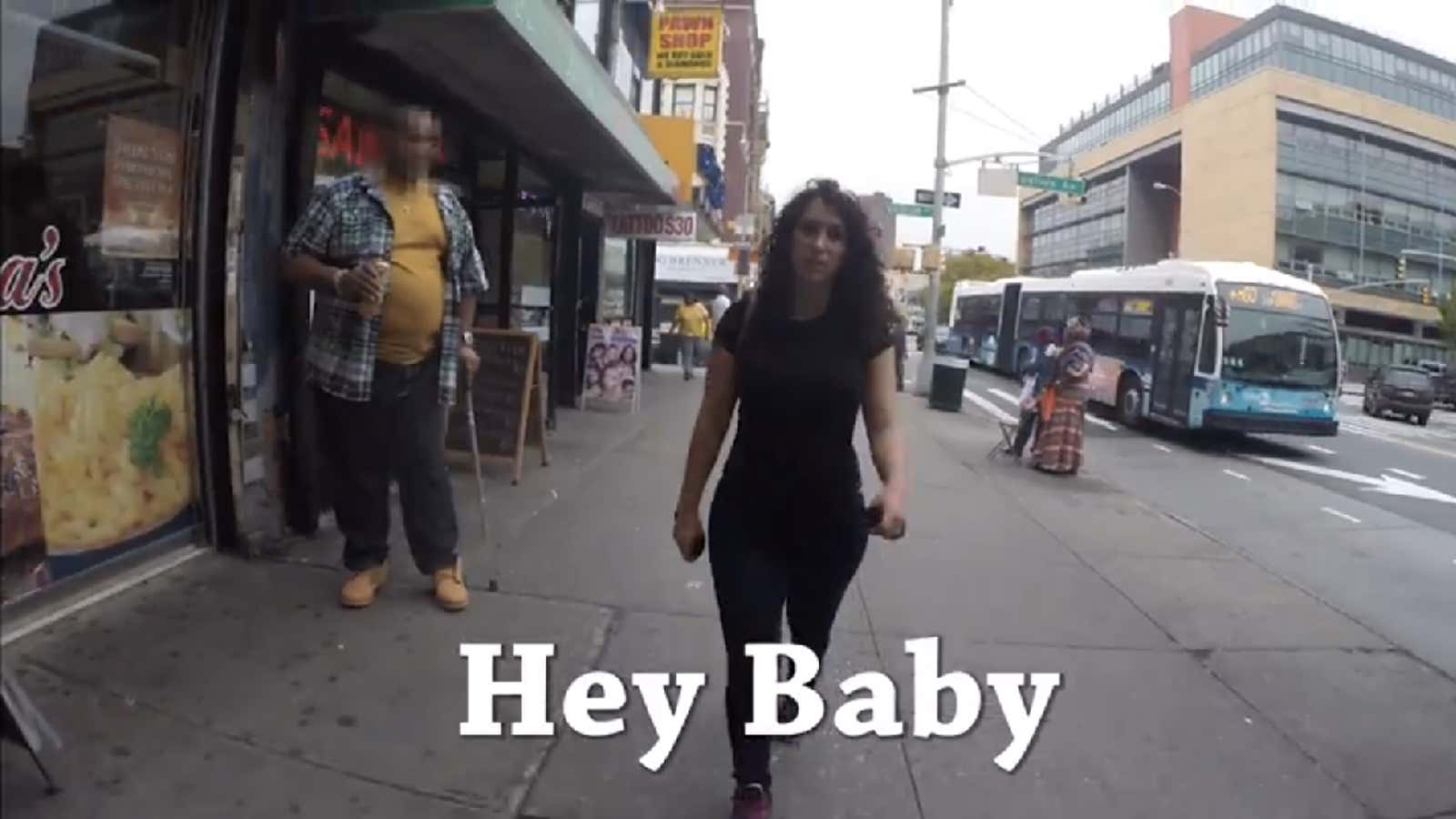This week, the internet exploded over a video showing men catcalling and harassing a young woman as she walked through the streets of New York City. While the piece, sponsored by the nonprofit “Hollaback,” seemed to be catching on like wildfire, it didn’t strike me as particularly original.
A few months ago, another similar video experiment in New York City rounded the internet via Upworthy. Buzzfeed has gotten in on it, too, with its own parody videos that interpret and reverse the gender roles catcalling men. And, just this past month, Daily Show correspondent Jessica Williams did a humorous skit on the pervasiveness of street harassment with a diverse set of women. Not to mention, there’s been a long-standing international grassroots campaign from artists, writers, and activists that has turned the term “street harassment” into part of the general lexicon.
So when this most recent catcalling video suddenly picked up steam, it wasn’t clear why it was gaining such traction. A closer look revealed a familiar trope that’s been with us in moving images since the days when Birth of a Nation captivated early American moviegoers—a lone, white woman traveling and leaving blurry, dark, and implicitly menacing men in her wake. And, by “dark,” I mean black—most of the figures in the video seen addressing the woman were black and Hispanic men. The choice to use a white actress in the video seemed especially odd, considering that women of color are significantly more affected by street harassment than their white female peers. And let’s not even tackle all of the problems that come with continuing to use young, able-bodied, and attractive white women to stand-in for all women.
I’m not the only one who noticed the strange racial dynamics in the video. At Slate, Hanna Rosin reports that the video’s production company admits to having edited out most of the white men who also catcalled the PSA’s star, Shoshana Roberts. Acclaimed feminist writer Roxane Gay tweeted that the video’s “racial politics are fucked up.” Also on Twitter, New Inquiry editor-in-chief Ayesha Siddiqi made a series of comments that criticized the way the video plays on race, gender and class, noting the way it seemed to let “white men in suits” off the hook for their everyday sexism. The gist of these arguments? Showing a highly edited video of a white woman being harassed by men of color drew attention to much more than modern-day street harassment.
Let’s put this in context. Between 1901-1930, more than 3,000 African-Americans were lynched in the United States of America—a study by Ida B. Wells suggested that at least 30% of them were driven by accusations of raping white women. As historian Sarah Carter writes in her book Capturing Women, “Images of white female vulnerability were exploited to convey the message of the necessity of policing the boundaries between black and white.” In other words, accusations and fears about white women under threat have been used as a way of defending and permitting the extrajudicial and legal policing, abuse, discrimination, and murder of countless African-Americans. Even worse, white women have historically deployed these images of marauding black men for their own political advantage and ambitions.
This stereotype is still with us, this mythos still pervasive. Last year’s resolution of the wrongful arrest, railroading, and conviction of four black teens (and one Hispanic) in 1989 for the rape of the “Central Park jogger” reminds us of the peril these characterizations pose. And, in the wake of the killings of Eric Garner, Rekia Boyd, and Mike Brown, and the unrelenting persistence of stop-and-frisk policies, it seems especially ironic to focus on white women in a national conversation on the harassment of American citizens on urban streets. Last week, a video showing a police officer threatening to “beat the shit” out of a black child walking home from school barely made it to local news.
Moreover, the speed at which city governments and organizations are jumping to fight “street harassment” seems strangely at odds with our nation’s general tendency to ignore or dismiss the more common acts of violence against women—intimate partner violence and sexual assault. Only a few years back, law enforcement officials across the country were deeming it not worth the time and money to prosecute domestic violence offenders. Yet, today, gentrifying cities like Washington, DC and Boston are investing major resources into ad campaigns and trainings for city workers that aim at protecting women from street harassment. In light of these disparities, these street harassment panics over “stranger danger” seem less about the danger and more about who gets to wield it.
Patriarchy and street harassment are real, scary, and dangerous. It doesn’t take a graduate degree in gender studies to understand that calling out and making comments about strangers passing on the street is not positive social behavior. It’s an exercise of male dominance and power that can easily lead to threats of violence and assault. But so too are the media images and narratives that single out “blackness” as its own threat to white security, selectively culling and dismissing the behavior of everyone else, are their own exercise of white supremacy.
They contribute to the illusion that black criminality and threats are present on every street corner, they justify the biased policing of brown and black male bodies, and they reinforce age-old myths about black hyper-sexuality and lasciviousness. Furthermore, they marginalize the experiences of black and brown women in the very same spaces.
Let’s end street harassment, for sure—but let’s do it for all of us.
